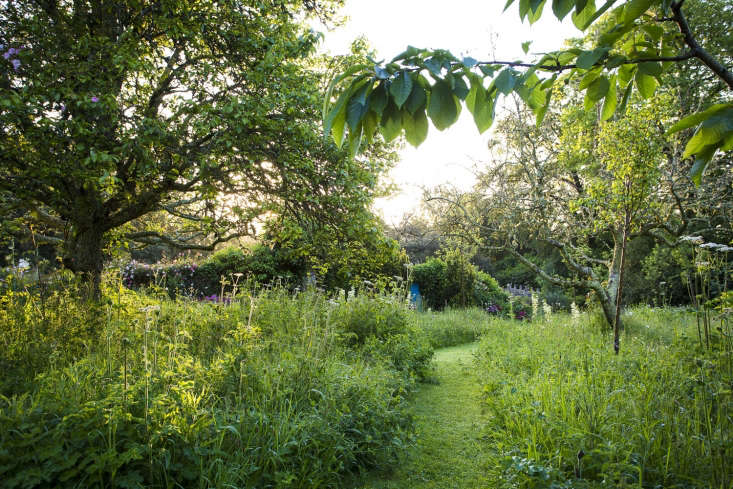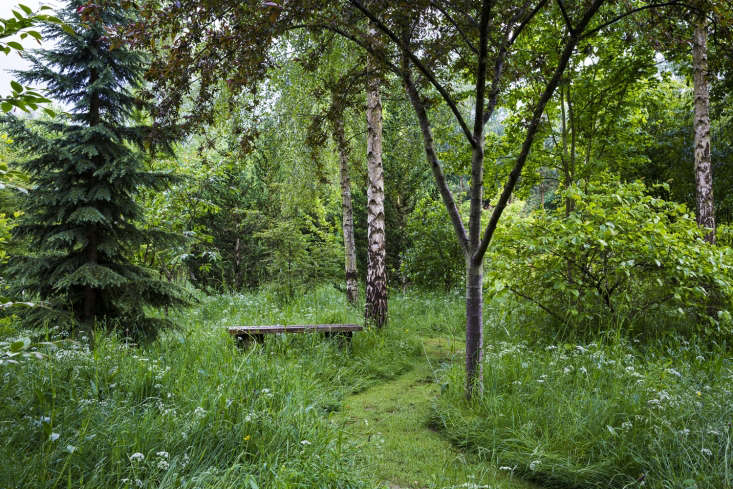Lawn mowing is many a gardener’s dilemma. On writing the book The Problem with My Garden, I was inspired by friends who were anxious: about the amount of work involved in gardening and about the amount of knowledge they felt they didn’t have. One friend in particular has always had big dreams, with limited resources or help. Blessed with an orchard and a ride-on mower, she continues to be aggravated by the trees themselves and wishes they would conform to her visions of grandeur:
Problem: Trees get in the way of the green sward.
Solution: Use grass to highlight trees’ beauty.
Photography by Claire Takacs.

“Can we cut out the turf around the trees,” says my friend, “and surround them with a ruff of boxwood, or at least fill them with wonderful plants?” I’d say: Resist the temptation to prettify. Tree “necklaces” create extra work and are a distraction from the main event: grass and trees.

In a larger property, such as the grounds of a medieval castle in Cornwall (shown above), there is room for an orchard as well as a formal lawn. The formal lawn by the house will more likely have trees around the edge than in the middle. In an area that has been deliberately planted with trees, allow them to express themselves and restrict the lawn mowing to defined paths. Lawn grass is patchy under trees, so take a more relaxed approach and put up a swing.
Into this longer grass, for which birds, insects and small mammals will thank you, plant perennial meadow plants, such as foxgloves, centaurea, and hardy geraniums. As well as spring bulbs. The wildflowers that have been waiting all these years to flower will surprise you. These may include cuckoo flower, vetch, scilla, wild orchids, and wild tulips.

A bench or low-slung chair in long grass might not be everyone’s idea of comfort, particularly in view of deer ticks, although a hammock by long grass is inviting. And short grass surrounded by long can be cut into a shape (circle, square, rectangle, something amorphous) rather than just used for passing places.
To reduce the vigor of green grass, while giving more display space to wild flowers, sow the seeds of yellow rattle (Rhinanthus minor) in September, so that it is exposed to the cold spell it needs over winter, to germinate effectively in spring. Yellow rattle is an attractive grass parasite; it mingles well with wildflowers but is anathema to perfect lawns.

The relaxed approach allows for quirks. The strong contrasts of straight with haphazard, and short with long, is messed up here by this single tree, hovering in the path. Instead of being moved, or repeatedly injured with a weed whacker, people instead move around the tree.

Lawns tend to get more attention than trees, with their regime of feeding, aerating, and re-sowing, plus hand-to-hand combat with buttercups, daisies, and dandelions. These flowers are no longer weeds when grown in long grass and in the end, it’s the trees that deserve more attention.
Learning how to prune fruit trees is invaluable as well as rewarding, and a well-pruned fruit tree will be shown to best advantage in long grass. For trees that need to find their own general shape without pruning, the canopy can at least be lifted, by removing one or two lower branches. Suckering shoots at ground level need to be removed. Keep it clean, without hacking away at the branches. This is more important than a vacuumed carpet-lawn.
For more garden solutions, you can order my new book, My Garden is a Car Park: and Other Design Dilemmas, for £12.99 from Amazon UK. For US readers, The Problem with My Garden can be ordered for $17.99 from Amazon.com.












Have a Question or Comment About This Post?
Join the conversation (0)